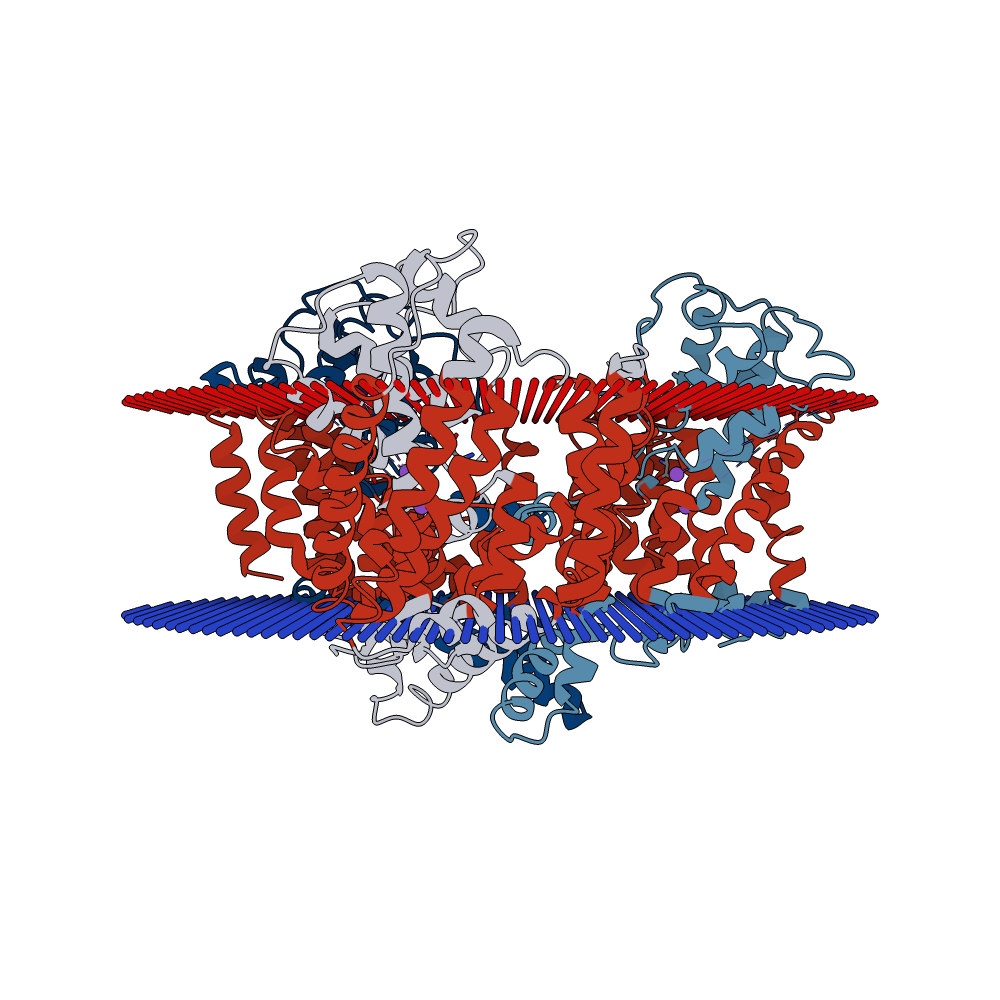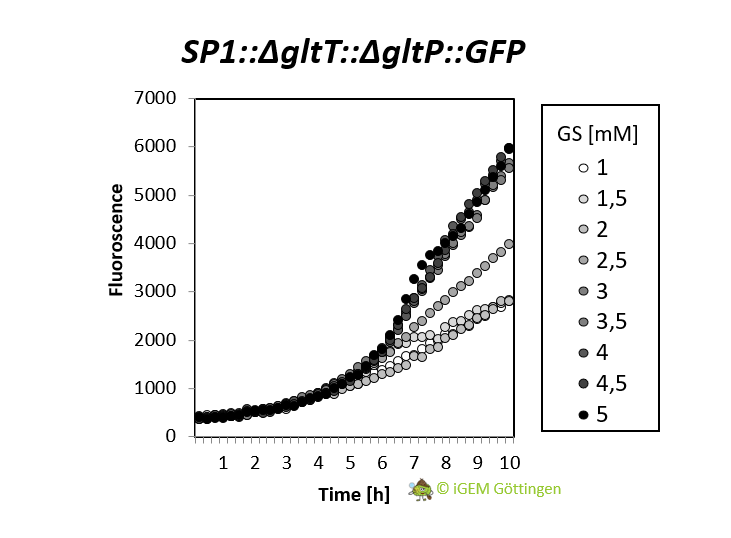Part:BBa_K2586001
GltT: glutamate and glyphosate transporter in B. subtilis
This part is coding for a glutamate and glyphosate transporter.
The DNA sequence of the gltT gene is coding for the GltT transporter, which is responsible for glutamate uptake into the cell. We found that GltT is also involved in glyphosate uptake in the Gram-positive model bacterium Bacillus subtilis.
Bacteria lacking the gltT gene are highly resistant to glyphosate because the herbicide is not transported into the cell. This part could be useful to engineer bacteria for the uptake and degradation of the weedkiller.
This biobrick is closely related to BBa_K2586002.
This biobrick is part of a composite biobrick BBa_K2586021.
| Locus | BSU10220 |
| Isoelectric point | 9.03 |
| Molecular weight | 45.76 |
| Protein length | 429 aa |
| Gene length | 1287 bp |
| Function | glutamate and aspartate uptake |
| Product | major Na+-couples glutamate/aspartate symport protein |
| Essential | no |
| Synonyms | yhfG |
Sequence and Features
- 10COMPATIBLE WITH RFC[10]
- 12COMPATIBLE WITH RFC[12]
- 21COMPATIBLE WITH RFC[21]
- 23COMPATIBLE WITH RFC[23]
- 25INCOMPATIBLE WITH RFC[25]Illegal NgoMIV site found at 742
Illegal NgoMIV site found at 1123 - 1000COMPATIBLE WITH RFC[1000]
Characterization
Deletion of gltT confers glyphosate tolerance
We tested whether the clean deletion of the gltT gene is sufficient to confer high-level resistance of B. subtilis to glyphosate. For this purpose, we constructed the mutant strain BP233 (gltT). To assess the glyphosate resistance of the gltT mutant, we cultivated the bacteria in CS-Glc minimal medium supplemented with increasing amounts of glyphosate. As shown in Figure 1A, growth of the wild type was inhibited by 5 mM glyphosate. The transporter with a high-affinity for glyphosate seems to be in fact GltT because the deletion of the gltT gene conferred high-level resistance to the herbicide (Figure 1C). Moreover, the growth rates of the strain BP233 (gltT) were reduced by 50% at herbicide concentrations of 6.1 mM (Figure 1B). Thus, in comparison to the wild type strain, 6-fold higher glyphosate concentration is needed to reduce the growth rate of the strain BP233 (gltT) by 50%.
Double mutant gltT gltP shows even higher glyphosate tolerance
In order to test whether the deletion of both gltT and gltP confers an even higher glyphosate tolerance, we constructed the mutant strain BP235 (gltT gltP). We cultivated the bacteria in CS-Glc minimal medium supplemented with increasing amounts of glyphosate. As shown in Figure 1D, the double deletion increased the glyphosate tolerance to 8.0 mM. Therefore, an 8-fold higher glyphosate concentration is needed to reduce the growth rate of the strain BP235 (gltT gltP) by 50%.

Fig. 1. Inactivation of the glutamate transporters confers high-level resistance to glyphosate. (A) Growth of the B. subtilis wild type (WT) strain 168 in CS-Glc minimal medium supplemented with increasing amounts of glyphosate (GS). (B) Growth of the Î(gltT) mutant strain BP233 in CS-Glc minimal medium supplemented with increasing amounts of glyphosate (GS). The figure inlay shows the relationship between the growth rate (”) and the glyphosate (GS) concentration.(C) Growth of the Î(gltT) Î(gltP) mutant strain BP235 in CS-Glc minimal medium supplemented with increasing amounts of glyphosate (GS). The figure inlay shows the relationship between the growth rate (”) and the glyphosate (GS) concentration.
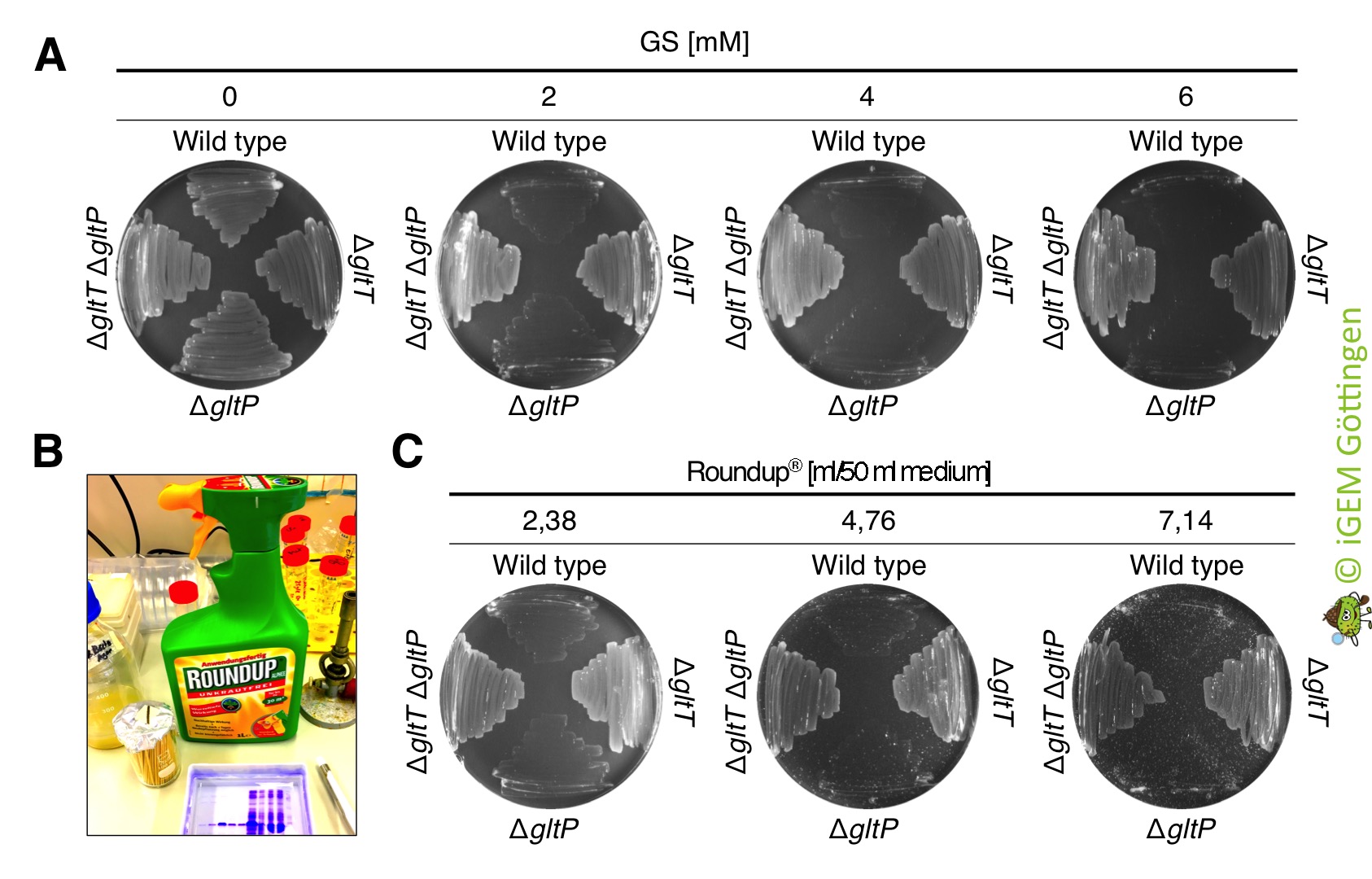
The deletion strains show also high resistance to commercially available RoundUp
We also tested whether the glyphosate that is present in commercially available RoundupÂź is toxic for B. subtilis. RoundupÂź was ordered from the german company Westfalia . 1 l of RoundupÂź Alphee contains 9.4 g of the isopropylamine salt of glyphosate (which corresponds to 7.2 g/l pure glyphosate), 5 g surfactant (undefined) and water. To test the effect of RoundupÂź Alphee on growth of the bacteria, we propagated the B. subtilis strains 168 (wild type ), BP233 (ÎgltT), BP234 (ÎgltP) and BP235 (ÎgltT ÎgltP) on CS-Glc minimal medium agar plates that were supplemented with glyphosate (control) and with equimolar amounts of glyphosate present in Roundup (test conditions). As shown in Figure 9, RoundupÂź Alphee killed the B. subtilis wild type strain and the strain lacking the low-affinity glutamate transporter GltP already at a concentration of 2 mM. By contrast, all strains lacking the high-affinity transporter GltT grew in the presence of 2 - 6 mM glyphosate that is present in Roundup.
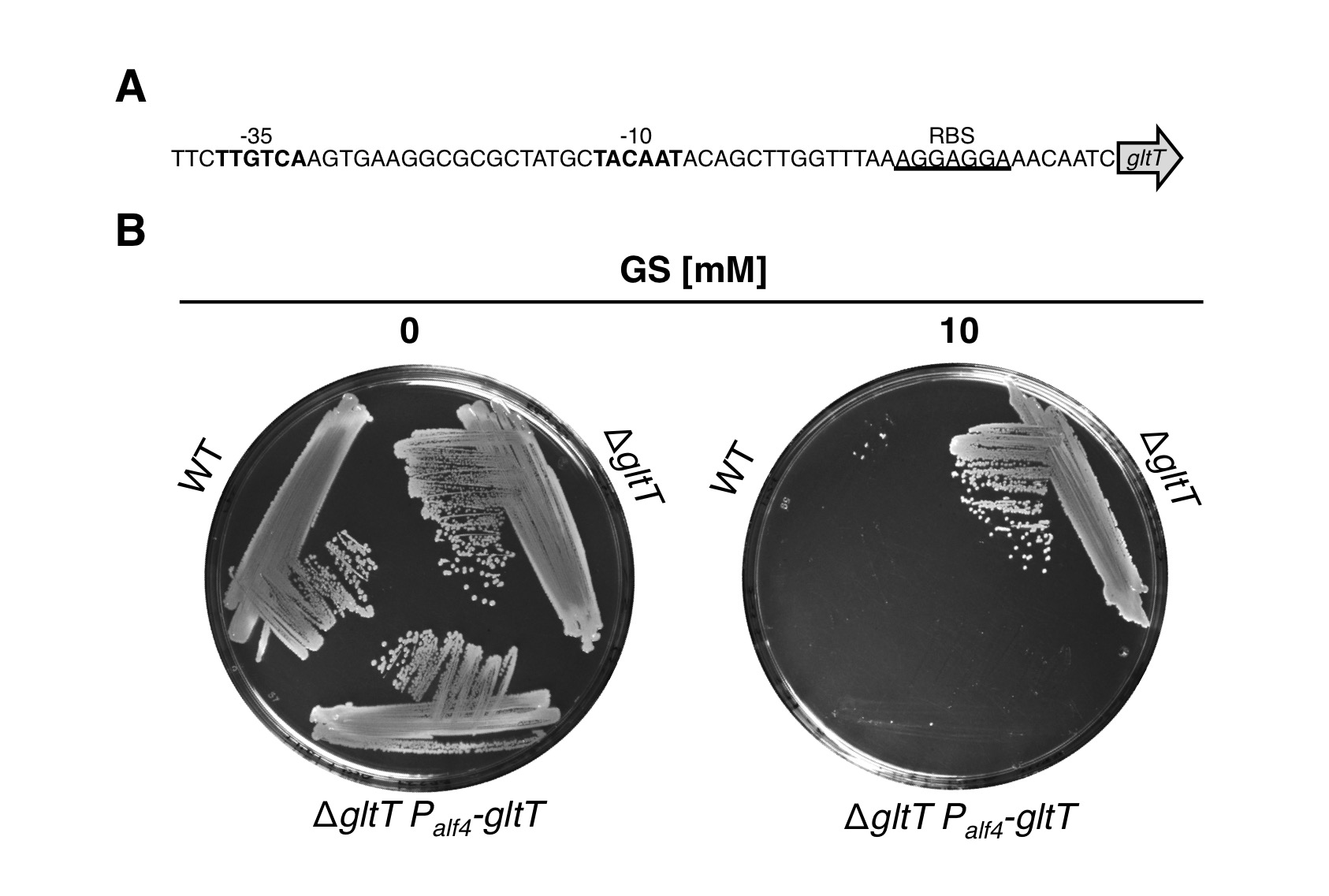
Complementation of the gltT mutation
We also performed a complementation experiment to provide further evidence that GltT is the major glyphosate transporter in B. subtilis. For this purpose, we fused the artificial Palf4 promoter ( BBa_K2586000) together with the gapA ribosome-binding site ( BBa_K2586008) to the gltT gene and integrated the construct into the amyE locus of the gltT mutant (Figure 3A). Next, we propagated the strains BP233 (gltT) and BP237 (gltT Palf4-gltT) together with the wild type strain 168 on agar plates without and with glyphosate (Figure 3B). As expected, all strains grew in the absence of glyphosate. By contrast, only the gltT mutant strain BP233 grew with glyphosate. Thus, like the wild type also the complementation strain BP237 take up glyphosate via GltT. To conclude, under the tested growth conditions the high-affinity glutamate transporter GltT is the major entryway of glyphosate into B. subtilis!

GltT is also involved in the uptake of the herbicide glufosinate
Our structural comparison of glutamate and glyphosate revealed that the two molecules resemble each other because they contain negatively charged groups encompassing positively charged groups. However, the structural similarity of glutamate and glyphosate is not very high. During a scientific discussion with our collaborator Dr. Till Ischebeck from the Department of Plant Biochemistry at the University of Göttingen, we came up with the idea that GltT may also transport the herbicide glufosinate, which is structurally more similar to glutamate than glyphosate and inhibits the glutamine synthetase (Figure 5) (Fraser and Ridley, 1984). Glufosinate (phosphinothricin) is a naturally occurring broad-spectrum systemic herbicide produced by several species of Streptomyces soil bacteria. Plants may also metabolize bialaphos (L-Alanyl-L-alanyl-phosphinothricin), another naturally occurring herbicide, directly into glufosinate (Fraser and Ridley, 1984).
The compound irreversibly inhibits glutamine synthetase, an enzyme necessary for the de novo synthesis of glutamine from ammonia and glutamate, giving it antibacterial, antifungal and herbicidal properties. Application of glufosinate to plants leads to reduced glutamine and elevated ammonia levels in tissues, halting photosynthesis, resulting in plant death. In the 1960s and early 1970s, scientists at University of TĂŒbingen and at the Meiji Seika Kaisha Company independently discovered that species of Streptomyces bacteria produce a tripeptide they called bialaphos that inhibits bacteria; it consists of two alanine residues and a unique amino acid that is an analog of glutamate that they named "phosphinothricin". The inactivation of the gltT gene indeed allowed B. subtilis to tolerate glufosinate (Figures 4B and 4C)! Moreover, the observation that the expression of two copies of the gltT gene in strain BP236 (amyE::Palf4-gltT) increased the sensitivity of the bacteria toward glufosinate further supports the idea that GltT is involved in glufosinate uptake by B. subtilis (Figures 4B and 4C). In contrast to glyphosate, however, the simultaneous deletion of the gltT and gltP genes did not increase glufosinate tolerance of B. subtilis (Figures 4B and 4C). To conclude, under the tested growth conditions the high-affinity glutamate transporter GltT is the major entryway of glyphosate into B. subtilis and GltT is also involved in Glufosinate uptake!
A novel mechanism conferring resistance to glyphosate
In the past years, the underlying molecular mechanisms conferring resistance to glyphosate have been intensively studied in bacteria and plants. In many cases glyphosate resistance is directly linked to the target of the herbicide. For instance, bacteria like S. aureus are a priori resistant to glyphosate because this organism synthesizes an insensitive EPSP synthase (13-16). Moreover, increased cellular levels of the EPSP synthase, which can be achieved either by overexpression of the coding gene or by gene amplification, can confer resistance to glyphosate (Figure 5) (9, 17-21). Due to the increased cellular levels of the EPSP synthase, the glyphosate is probably titrated away and sufficient amounts of the precursor for aromatic amino acid biosynthesis can be produced.
As mentioned in the design section, several glyphosate-insensitive EPSP synthase mutant variants have been isolated and engineered (11, 22-35). Often, a single amino acid exchange is sufficient to render the EPSP synthase insensitive to glyphosate. However, although glyphosate resistance is frequently linked to the target of the herbicide, resistance against the herbicide may occur by other means. Several studies have demonstrated that glyphosate can be detoxified by covalent modification. For instance, the Gat glyphosate N-acetyltransferase from Bacillus licheniformis, which was subjected to directed evolution for creating an enzyme with higher efficiency and increased specificity for the herbicide, converts glyphosate to N-acetylglyphosate, which is not herbicidal and is not an effective inhibitor of EPSP synthases (Figure 9) (36-39). Moreover, the hygromycin phosphotransferases Hph and GlpA from E. coli and Pseudomonas pseudomallei, respectively, phosphorylate glyphosate and thus confer tolerance to the herbicide (Fig. 3) (40,41). Interestingly, the gat gene has also been used as a selection marker for genetic engineering of bacteria (39). The enzymes that covalently modify glyphosate have been successfully introduced into crops to increase herbicide resistance (42).
Recently, it has been also demonstrated that enhanced export of glyphosate can reduce toxicity of the herbicide. For instance, the overexpression of the uncharacterized membrane proteins MFS40 and YhhS from Aspergillus oryzae and E. coli, respectively, with similarity to the major facilitator secondary transporter superfamily, enhance glyphosate tolerance of E. coli (Figure 5) (43,44). It will be interesting to test whether these transporters are suitable for engineering crops to enhance glyphosate tolerance. Proteins of unknown function can also increase glyphosate tolerance. For instance, the overexpression of the igrA gene product from the Pseudomonas sp. strain PG2982 increases glyphosate tolerance in transgenic rice (45-47). Finally, many bacteria can survive in the presence of glyphosate because they are able to degrade the herbicide (Figure 5) (48-57). To conclude, several mechanisms of glyphosate resistance have been described over the past years and novel mechanisms allowing survival with the herbicide are certainly identified in the future. We have observed that the deletion of the gltT gene in B. subtilis confers high-level glyphosate resistance to the bacteria. The B. subtilis gltT mutant strain could be a suitable host to identify glyphosate uptake systems from plants by expressing cDNA libraries and by screening for transformants that are unable to grow with glyphosate.
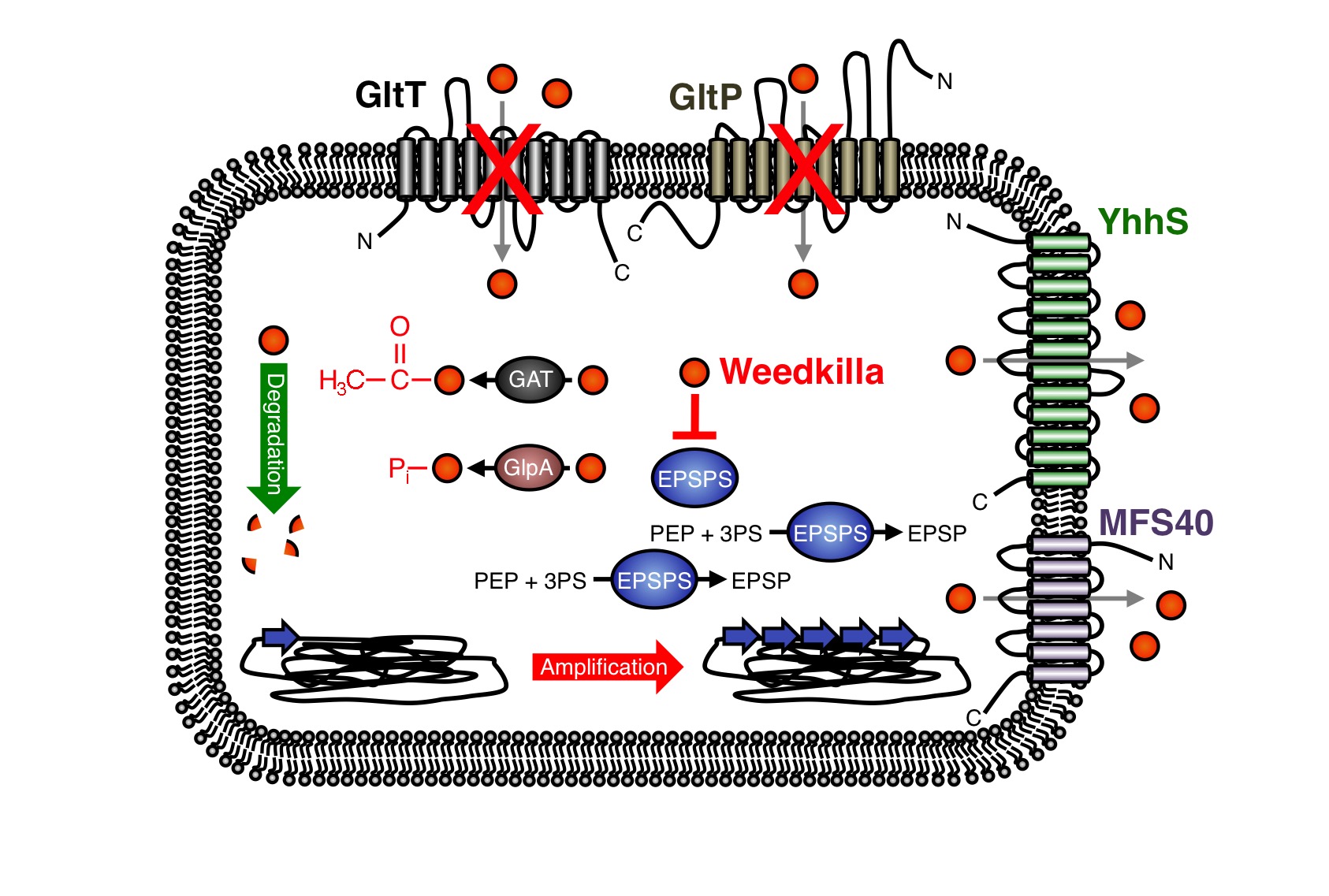
Usage and Biology
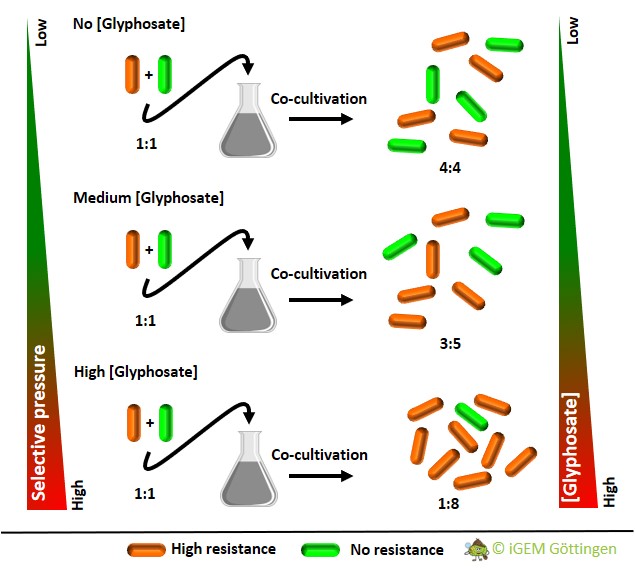
Competition assay with fluorophores
Unfortunately, current analytical methods, which are based on enzyme-linked immunosorbent assays (ELISAs) and mass spectrometry (MS) are very expensive, slow, need sophisticated equipment and well-trained technical staff. Therefore, the development of a rapid and straightforward method to detect glyphosate is very attractive because the intensive use of the herbicide may lead to its accumulation in the soil and food. The basic idea of the competition assay for the detection of glyphosate is depicted in figure 6.
Two B. subtilis strains that tolerate different amounts of glyphosate are labelled with different fluorophore genes. The fluorescence labelling of the bacteria allows to count the amount of each strain when co-cultivated in the absence and in the presence of selective pressure that is exerted by glyphosate using fluorescence microscopy. In the absence of selective pressure, we expect that both strains will survive the co-cultivation. By contrast, in the presence of glyphosate, the strain that tolerates glyphosate will outcompete the glyphosate-sensitive B. subtiles strain. Thus, the selective pressure (â [glyphosate]) correlates with the amount of glyphosate-resistant cells and glyphosate-sensitive cells.
To create a powerful glyphosate detection system, which is based on intraspecies competition, we need to have strains with similar fitness . Strains having a different fitness will not allow to generate a stable co-culture because the strain with the higher fitness will alway outcompete the other strain, even in the absence of a selective pressure.
To characterize our strains and to determine their fitness we performed different growth experiments. First, we integrated fluorophore genes into the amyE gene of the B. subtilis strains 168, (wild type), ÎgltT (BP233) and ÎgltT ÎgltP (BP235) (Figure 7). The wild type strain 168 is very sensitive to glyphosate. By contrast, the ÎgltT single mutant and ÎgltT ÎgltP double mutant lacking the glyphosate transport systems tolerate high amounts of the herbicide (see above).
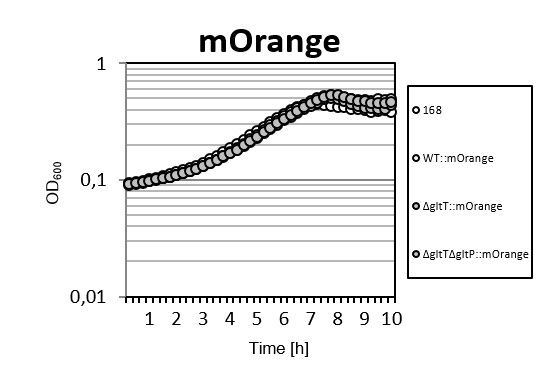
We used the gfp, bfp and morange ( BBa_E2050 ) genes encoding the fluorophores GFP, BFP and mOrange, respectively, for strain labeling. To drive the expression of the fluorophore genes, we attached an artificial promoter to the genes during PCR. The sigma factor A-dependent artificial promoter is constitutively active and contains a ribosome binding site for B. subtilis. Next, we cultivated the constructed strains in a multi-well plate reader, to determine their fitness based on the growth rates that are achieved in the medium.
As shown in Fig. 7, all strains have similar growth rates in CS-Glc minimal medium. Thus, the expression of the mOrange gene and the absence of the glyphosate transporters GltT and GltP does not affect the fitness of the strains!
To detect glyphosate by intraspecies competition, we mixed the wild type strain synthesizing the GFP protein with the ÎgltT ÎgltP double mutant synthesizing the mOrange fluorescence protein in a 1:1 ratio. As shown in Fig. X, the amount of wild type cells decreased in the co-culture with increasing glyphosate concentrations.
By contrast, the amount of cells of the strain carrying the mOrange gene increased with increasing glyphosate concentrations since the ÎgltT ÎgltP mutant tolerates the herbicide glyphosate. Thus, the intraspecies competition assay, which is based on fluorescently labelled B. subtilis strains seems to be suitable to detect glyphosate!
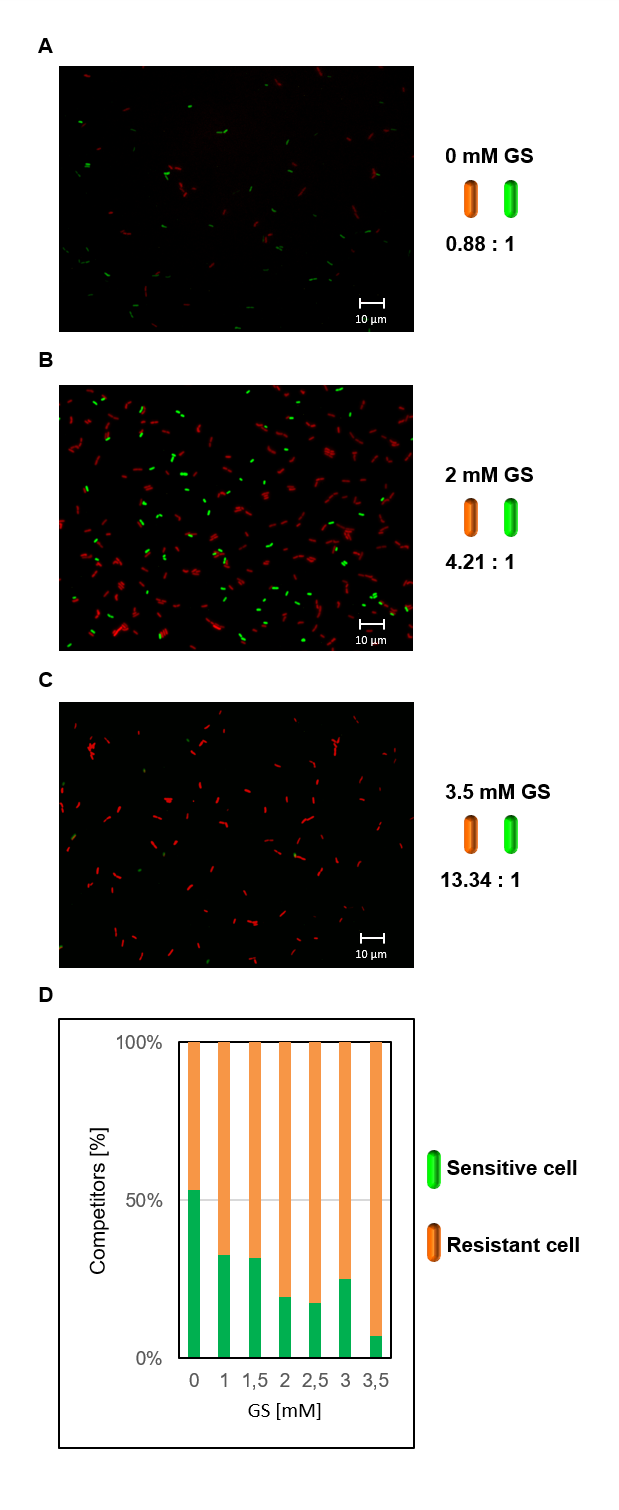
The number of green cells in comparison to the orange cells decreases with increasing glyphosate concentrations.
To perform a competition assay in a greater scale, we used a platereader for our growth experiments. This device enabled us to measure different fluorophores and the optical density simultaneously. Strains were cultivated in CS-glucose (CS-Glu) medium to an OD600 of 1â1.5. A 96âwell plate was prepared containing 100 ”L of CS-Glu medium with the desired concentrations of glyphosate. 10 ”L of the cell mixture (1:1 ratio) were transferred into the wells to obtain an OD600 of 0.1 in the wells. We used the SynergyMx by BioTek for our measurements. GFP was excited at 488 nm and emission was measured at 509 nm. for mOrange, the excitation wavelength was 529 nm and emission was detected at 562 nm.
This competition assay enables us to calculate the concentration of glyphosate in samples from people that are curious, how much glyphosate is in their soil.
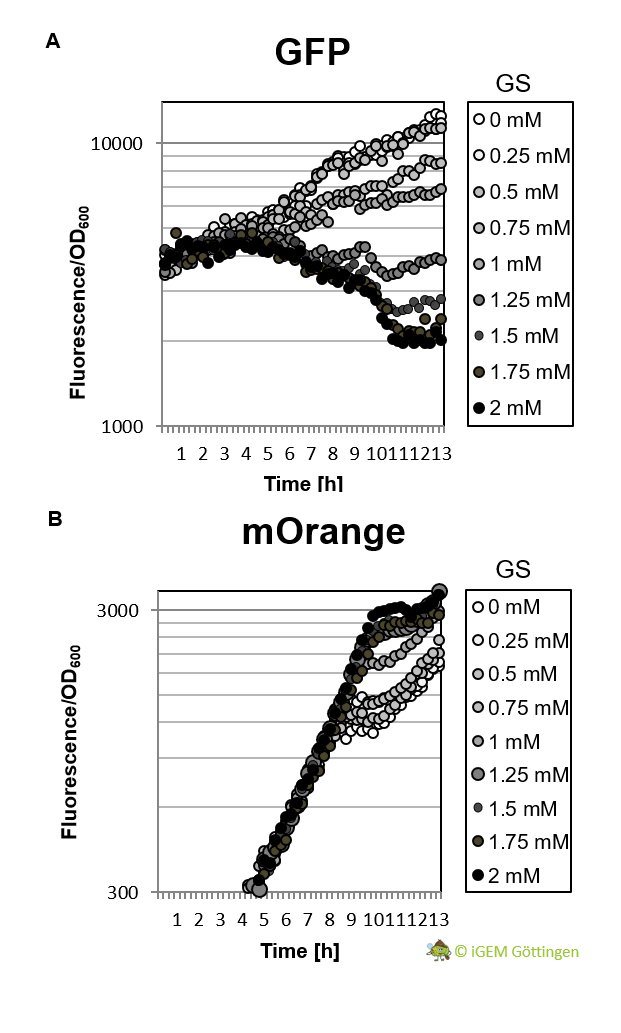
Competition with ÎČâgalactosidase expressing strains
Another approach using competition assays is to use enzymatic indication systems. Therefore, we used the strain BP235 (ÎgltT ÎgltP) and the strain BP193 (palf4::lacZ) (61). As previously described, BP235 is characterized by high-level glyphosate resistance, while BP193 resembles the wildtype despite the lacZ gene. The promoter palf4 is an artificial one and harbors a perfect consensus sequence for Bacillus subtilis and a ribosome binding site. This leads to constitutive expression of the lacZ gene and to blue cells if the medium is supplemented with X-Gal. Cultures of both strains in CS-Glu medium without glyphosate were mixed to obtain a 1:1 ratio of both strains and incubated with increasing glyphosate concentrations (0â5 mM) for 24 h (Figure 10).
The intensity of the blue color drecreases with increasing glyphosate concentrations (Figure 10). The change and intensity of the blue color correlates with the glyphosate concentration and can therefore be used as detection and quantification system. Furthermore, a ÎČâgalactosidase assay can quantify the activity of the promoter palf4 and thus, the concentration of glyphosate.
In an additional step, we verified that the change in coloration occurred due to the death of the sensitive strain on the one hand and the increased growth of the resistant BP235 strain on the other hand. Hence, we adopted the experimental set up and analysed growth of the two strains in the platereader. To analyse growth of BP235, we used the strain constitutively expressing GFP, which was constructed similarly to the previously used strains. For the analysis we again used 100 ”L CS-Glu medium supplemented with the appropriate glyphosate concentration. The cells were added in a 1:1 ratio. GFP was excited at 488 nm and emission was measured at 509 nm.
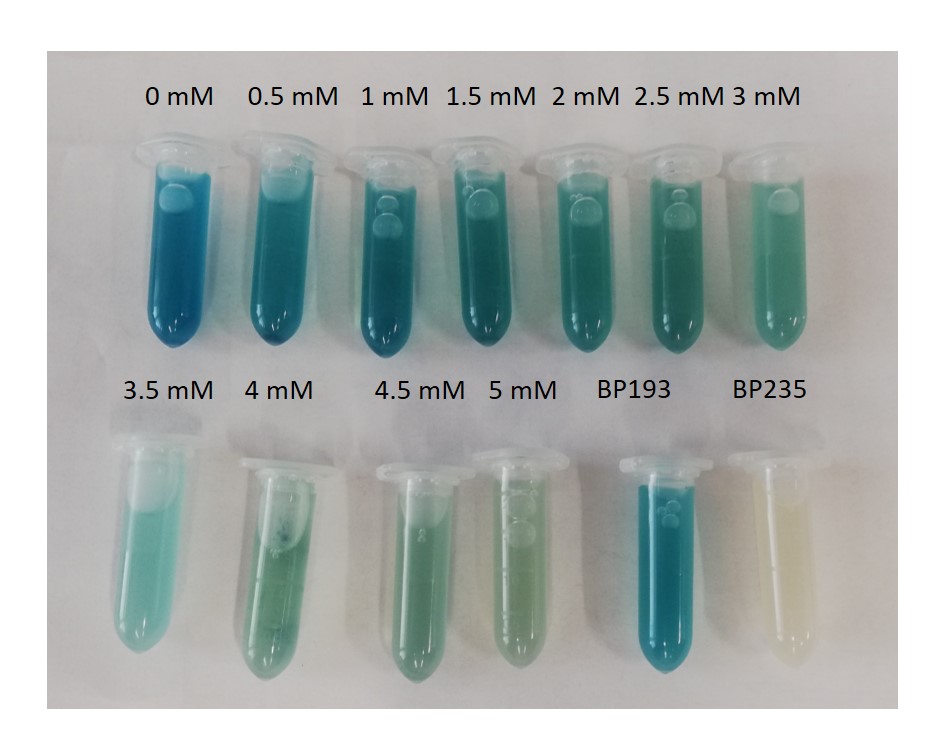
References
1. Fischer et al. (1986) J. Bacteriol. 168: 1147-1154
2. Zeigler et al. (2008) J. Bacteriol. 190: 6983-6995.
3. Barbe et al. (2009) Microbiology 155: 1758-1775
4. Kearse et al. (2012) Bioinformatics 28: 1647-1649.
5. Omasits et al. (2014) Bioinformatics. 30: 884-886.
6. Michna et al. (2014) Nucleic Acids Res. 42: D692âD698.
7. Zaprasis et al. (2015) Appl. Environ. Microbiol. 81: 250-259.
8. Tolner et al. (1995) J. Bacteriol. 177: 2863-2869.
9. Amrhein et al. (1980) Naturwissenschaften 67: 356-357.
10. Comai et al. (1983) Science 221: 370-371.
11. Stalker et al. (1985) J. Biol. Chem. 260: 4724-4728.
12. Gundlach et al. (2017) Sci. Signal. 10: eaal3011.
13. Priestmann et al., (2005) FEBS Lett. 579: 728-732.
14. Cao et al. (2012) PLoS One. 7: e38718.
15. Light et al. (2016) Biochemistry 55: 1239-1245.
16. Liu & Cao, (2018) Biotechnol Lett. 40: 855-864.
17. Rogers et al. (1983) Appl. Envrion. Microbiol. 46: 37-43.
18. Gaines et al. (2011) J Agric Food Chem. 59: 5886-5889.
19. Juglam et al. (2014) Plant Physiol. 166: 1200-1207.
20. Sammons & Gaines (2014) Pest. Manag. Sci. 70: 1367-1377.
21. Dillon et al. (2017) Plant Physiol. 173: 1226-1234.
22. Sost & Amrhein (1990) Arch. Biochem. Biophys. 282: 433-436.
23. Padgette et al. (1991) J. Biol. Chem. 266: 22364-22369.
24. He et al. (2001) Biochim. Biophys. Acta 1568: 1-6.
25. He et al. (2003) Biosci. Biotechnol. Biochem. 67: 1405-1409.
26. Bearson et al. (2002) Plant Physiol. 129: 1265-1275.
27. Eschenburg et al. (2002) Planta 216: 129-135.
28. Sun et al. (2005) Appl. Envrion. Microbiol. 71: 4771-4776.
29. Zhou et al. (2006) Plant Physiol. 140: 184-195.
30. Healy-Fried et al. (2007) J. Biol. Chem. 282: 32949-32955.
31. Vande Berg et al. (2008) Pest. Manag. Sci. 64: 340-345.
32. Funke et al. (2009) J. Biol. Chem. 284: 9854-9860.
33. Tian et al. (2010) Appl. Environ. Microbiol. 76: 6001-6005.
34. Pollegioni et al. (2011) FEBS J. 278: 2753-2766.
35. Chekan et al. (2016) MedChemComm. 7: 28-36.
36. Castle et al. (2004) Science 304: 1151-1154.
37. Siehl et al. (2005) Pest. Manag. Sci. 61: 235-240.
38. Siehl et al. (2007) J. Biol. Chem. 282: 11446-11455.
39. Norris et al. (2009) Appl. Environ. Microbiol. 75: 6062-6075.
40. Rao et al. (1983) Antimicrob. Agents Chemother. 24: 689-695.
41. Penaloza-Vazquez et al. (1995) Appl. Environ. Microbiol. 61: 538-543.
42. Liu et al. (2015) Transgenic Res. 24: 753-763.
43. Staub et al. (2012) J. Ind. Microbiol. Biotechnol. 39: 641-647.
44. Tao et al. (2017) Pestic. Biochem. Physiol. 140: 65-68.
45. Fitzgibbon & Braymer, (1988) Appl. Environ. Microbiol. 54: 1886-1888.
46. Fitzgibbon & Braymer, (1990) Appl. Environ. Microbiol. 56: 3382-3388.
47. Fartyal et al. (2018) Front. Plant. Sci. 13: 144.
48. Pipke et al. (1980) Appl. Environ. Microbiol. 53: 974-978.
49. Shinabarger et al. (1986) J. Bacteriol. 168: 702-707.
50. Liu et al. (1991) Appl. Environ. Microbiol. 57: 1799-1804.
51. Dick & Quinn, (1995) Appl. Microbiol. Biotechnol. 43: 545-550.
52. Singh & Walker, (2006) FEMS Microbiol. Rev. 30: 428-471.
53. Castro et al. (2007) J. Environ. Sci. Health B. 42: 883-886.
54. Hove-Jensen et al. (2014) Microbiol. Mol. Biol. Rev. 78: 176-197.
55. Kryuchkova et al. (2014) Microbiol. Res. 169: 99-105.
56. Sviridov et al., (2011) Biochemistry (Mosc). 76: 720-725.
57. Sviridov et al. (2015) Prikl. Biokhim. Mikrobiol. 51: 183-190.
58. Lu et al. (2013) Mol Biosyst. 9: 522â30.
59. Gaballa & Helmann (1998) J Bacteriol. 180: 5815â5821.
60. Gaballa et al. (2002) J Bacteriol. 184: 6508â6514.
61. Gundlach et al. (2017) Science Signaling 10: eaal3011
//chassis/prokaryote/bsubtilis
| resistance |

